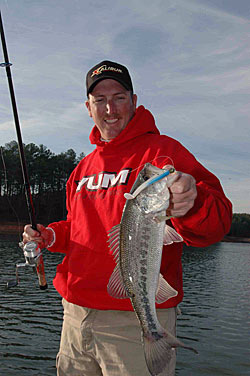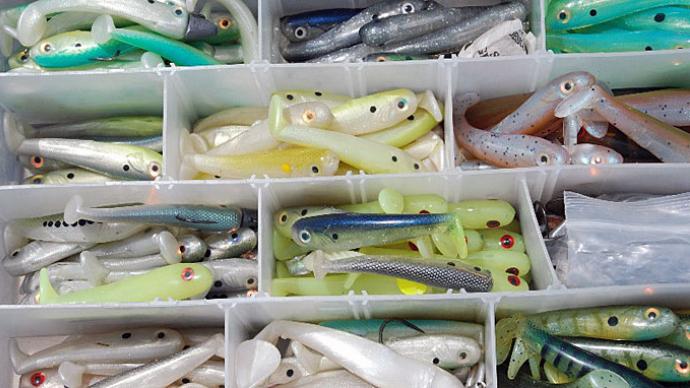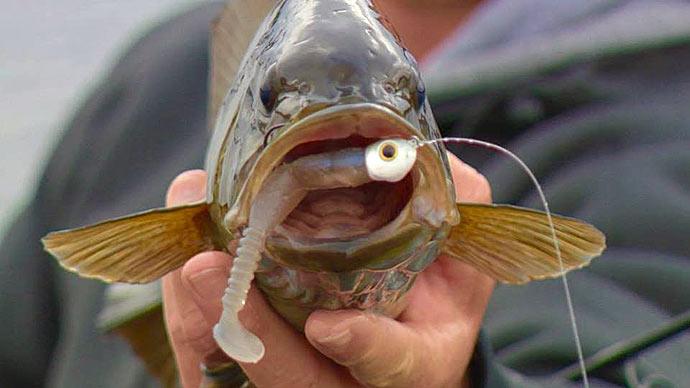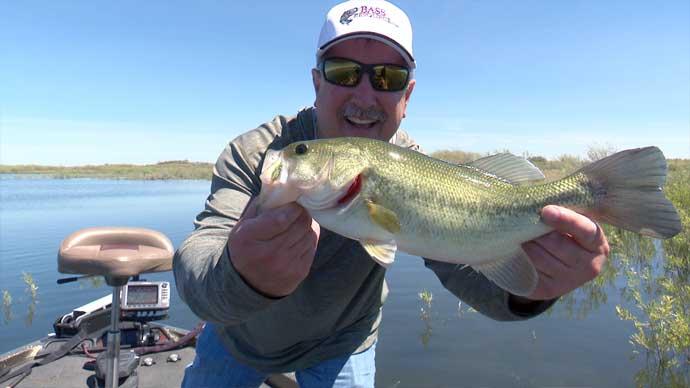
Less is more sometimes for Jimmy Mason when he fishes paddletail swimbaits in the winter.
The Alabama guide frequently loads up an Alabama rig with multiple paddletail swimbaits to trick wintertime bass. However, there are certain situations when a single swimbait on a jighead produces more bass for him. Many tournaments now prohibit Alabama rigs, so Mason resorts to the single swimbait when competing in those events. Mason also favors the control he can maintain with a single swimbait over the multiple bait Alabama rig when fishing in current on the Tennessee River chain of lakes.
“We have a lot of winter floods and periods where we get a lot of current,” he says. The single swimbait is more effective for Mason than the Alabama rig when he needs to bounce the lure over boulders or to keep his bait close to bluffs or grass lines.
The swimbait’s tail action and looks make it an ideal lure for wintertime fishing. “You can fish it slow,” Mason says. “With that big lazy paddle it just imitates a crippled or dying shad. It is just a natural retrieve that you can control by slowing down. You can fish it suspended very well and can control it by counting it down through the balls of suspended shad. As the water gets colder and the shad get lethargic before they die, that’s a great time for that swimbait.”
Mason’s favorite paddletail swimbaits for wintertime fishing are the hollow-body Yum Money Minnow and the solid-body 4.5-inch Yum Pulse. His swimbait color choices are foxy shad for imitating the threadfin shad of the Tennessee River and olive shad or Tennessee shad for fishing in clear water.
The Alabama angler opts for a 3 1/2-inch Money Minnow with a 1/8- or 1/4-ounce jighead when fishing the swimbait similar to a plastic grub for suspended bass in open water on clear-water reservoirs. His tackle for this finesse tactic includes a 7-foot, medium-action Team Lew’s Custom Lite Speed Stick spinning rod and Lew's Custom Lite Series Spinning Reel reel filled with 8-pound Vicious Pro Elite Fluorocarbon.
Mason switches to the 5-inch Money Minnow or the Pulse swimbait with heavier gear when fishing around rocks or grass. He attaches the swimbait to a Buckeye J-Will Swimbait Head in 1/4-, 3/8, 1/2- or 3/4-ounce sizes depending on the depth of the fish. Mason throws the larger swimbait on a 7 1/2-foot Team Lew’s Custom Pro Mark Rose Ledge Series Swimbait rod and Team Lew’s Custom Pro Speed Spool 6.8:1 baitcast reel spooled with 15-pound Vicious Fluorocarbon.

Creek and river channels are the fundamental structures Mason targets for throwing his paddletail swimbaits. His favorite spot to fish is a causeway where bass funnel into the narrowed channel. The veteran angler studies his electronics to determine the depth of baitfish relating to the channel and then tries to keep his swimbait at the same depth. Mason notes he sometimes catches bass as deep as 25 feet on the swimbait, but most of his bites come from the 15- to 20-foot range.
The prime time for Mason to throw his single swimbait is after heavy rains create lots of current and eddies in a causeway or tailrace. Mason runs his swimbait through the eddies with a slow and steady retrieve.
The guide suggests less is also more when retrieving the swimbait. Mason notices that some of his clients try to impart action to the swimbait by twitching it like a jerkbait, but he triggers more strikes with less action. “The swimbait is one of those deals that I feel like I get fewer bites when hopping it, especially when I start feeling a fish hitting at it,” he says. “We call it ‘head-butting’ or ‘playing volleyball’ because you will start getting those little bumps, and your rod will load up after two or three of those little bumps. In my experience, the fish will turn away from it if you do anything other than a continuous retrieve when you start feeling that activity.”
The only time Mason varies his retrieve is when he notices the lure is losing contact with the bottom, so he reels slower until the swimbait regains bottom contact.
When fishing submerged eelgrass in the wintertime, Mason runs the swimbait and jighead or a Pulse swimbait attached to a bladed jig over the top of the vegetation. When the lure reaches the edge of the grass, Mason stutter-steps his reeling, so the lure falls 6 inches or 1 foot into the channel. The slightly falling swimbait triggers strikes from bass suspending along the edge of the weeds.
The single swimbait produces both numbers of bass and quality fish during the winter. “It is a quality fish bait, but at certain times of the year and in certain situations, you will catch a lot of fish,” Mason says. The biggest largemouth bass he has caught on the single swimbait weighed about 9 1/2 pounds, and his biggest smallmouth bass weighed 8 pounds, 2 ounces. The guide claims he has caught more than 50 smallmouth weighing over 7 pounds on the lure.
His best day for sheer numbers of fish was when a client weighed and counted all of their catches. Mason and his two clients caught largemouth and smallmouth bass with a 5-inch Money Minnow on a 1/2-ounce jighead. “Our best 20 fish weighed 99 (pounds),” Mason says. They finished the day with a catch of 49 bass consisting of five largemouth and 44 smallmouth.
BassResource may receive a portion of revenues if you make a purchase using a link above.




